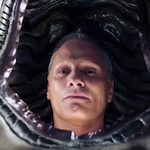 (warning: to the extent you can spoil a movie like CRIMES OF THE FUTURE, this review contains spoilers)
(warning: to the extent you can spoil a movie like CRIMES OF THE FUTURE, this review contains spoilers)
CRIMES OF THE FUTURE is your typical undercover story – a guy is working for The Man and thinks he’s doing the right thing, but through his investigation he starts to see a different perspective, rethinks his loyalties, and questions whether or not to narc these people out. In this case the guy is a performance artist famous for growing inexplicable new internal organs and having them removed in front of an audience by laying in a machine that looks like a chrysalis, with robotic bone arms cutting him open under the control of a partner sensually poking her fingers into a gooey bladder. And the people he may or may not bust are (spoiler) an underground movement of people surgically altering their digestive systems so that they can eat plastic. But you’ve seen that before too. Just a good old fashioned organ opera like the ones we all grew up on.
Okay, yeah, on second thought maybe it’s fair to say that this is a weird fuckin movie that could only be made by writer/director David Cronenberg (TOP GUN [offered but turned down]). When he did that trilogy of more reality-based Viggo Mortensen joints (A HISTORY OF VIOLENCE, EASTERN PROMISES and A DANGEROUS METHOD) people thought he’d moved beyond slimy mugwumps and uncharted glands and shit, and that this is a throwback. But he wrote and tried to make this before all those, so maybe he’s just getting back on track.
Either way, this has a scene where Mortensen (AMERICAN YAKUZA) has had a zipper installed on his belly and can open it up, and Léa Seydoux (MISSION: IMPOSSIBLE – GHOST PROTOCOL) pleasures him by spreading it open and licking his innards. So it was cool to see at a multiplex on a giant screen with Minions ads and shit playing before it. The summer movie season has finally begun.
This is not one of the movies where the narrative is the most important thing. It’s more about taking a walk through this odd world, experiencing the sickly ambience of the place, feeling your comfort with its reality slowly tweaked by the odd names, technologies and organizations you encounter. Maybe the most crucial aspect of it is that most of the acting performances (and especially Mortensen’s) are pretty grounded. They’re not taking the occasion of being in a weird movie to go mega – they’re treating it like yeah, no shit, this is our life now. Why wouldn’t it be? We’re just people like you.
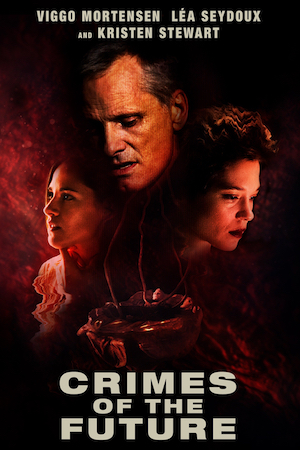 After a mysterious opening scene about a woman (Lihi Kornowski) seeing her young son Brecken (Sozos Sotiris) eat a plastic garbage can and then smothering him with a pillow, it cuts to some other location, where a huge, organic, possibly vegetable pod, maybe the size of a couch, is suspended from the ceiling by tendrils. It took me a bit to spot a foot in there, and then make out a full human body laying inside it, and then realize that it was Viggo, whose character is named Saul Tenser. This is his bed.
After a mysterious opening scene about a woman (Lihi Kornowski) seeing her young son Brecken (Sozos Sotiris) eat a plastic garbage can and then smothering him with a pillow, it cuts to some other location, where a huge, organic, possibly vegetable pod, maybe the size of a couch, is suspended from the ceiling by tendrils. It took me a bit to spot a foot in there, and then make out a full human body laying inside it, and then realize that it was Viggo, whose character is named Saul Tenser. This is his bed.
“Wake up, darling,” says Saul’s life/surgery partner Caprice (Seydoux), like it’s completely normal. She asks him how he slept and he says that his OrchidBed needs a software update. In this future most people don’t feel pain, but because of his Accelerated Evolution Syndrome he does, and he has to plug into these biomechanical devices to make his organs work properly. No problem, she’ll call LifeFormWare and get somebody to come take a look at it.
Though their home, like all the locations in the movie, is weathered and dilapidated, I get the impression that Saul and Caprice are living a good upper class life. They certainly own some presumably expensive shit. In addition to the OrchidBed, Saul eats in a LifeFormWare chair that looks like bones and skin, that jerks him around to align his spine and esophagus for proper digestion. And when the I.T. team of Berst (Tanaya Beatty, True Justice) and Router (Nadia Litz, TEEN SORCERY) come to the house they’re excited to see in the records that he owns a Sark, an old model of autopsy machine that’s so rare they’ve never seen one in person.
(You know – one of those rock solid home autopsy machines they used to make back in the day. The ones they make now are crap.)
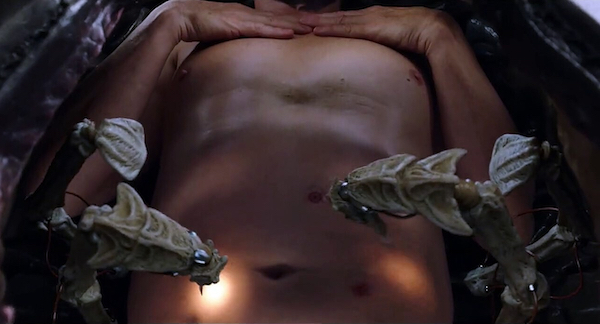
That’s the machine I described in the first paragraph, which they’ve customized for their performances, including adding tattoo guns to its skeletal scalpel arms. I love how the delightful Berst and Router admire this machine and talk about it like a rare classic motorcycle or sports car that’s been lovingly maintained and pimped out over the years by this guy who lives his life a quarter inch incision at a time. They’re excited to go look at it, to put their hands on it, in fact to take their clothes off and hop inside. So maybe it’s more exciting than a car!
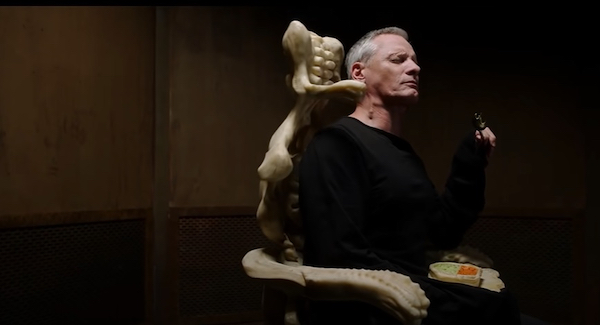
But the OrchidBed and the chair seem more like a top of the line Sleep Number bed or smart kitchen appliance. There’s an underlying dark (but very dry) humor to much of this movie, including when the characters marvel at these aggressively bizarre creations as if they’re high end luxury items. A few times I thought of an obscure comedy called MEET THE HOLLOWHEADS, which takes place in a dystopian future where much of the technology is tube or tentacle based. But the joke there was to have an exaggerated ‘50s sitcom type family using this weird shit. Cronenberg’s approach is to make the people real.
For reasons I didn’t totally understand, Saul for the first time goes to the National Organ Registry to have a new organ registered. Just being a responsible citizen, I guess. It’s a tiny, shitty office that in our world you would be very nervous about if it was somewhere you went to do business. The bossman Wippet (Don McKellar, director of the movie LAST NIGHT) and especially his assistant Timlin (Kristen Stewart, JUMPER) seem very excited to be meeting Saul, treating him like a celebrity. That might just be because of the business they’re in, but I get the impression that performance artists are the rock stars of this future. Either way, Timlin is a big fan, bordering on groupie, and Stewart is the one actor who gets to guitar solo a little bit with her performance, shifting between mousy timidity and barely restrained lust as she interacts with him.
Though in public Saul acts like some disfigured horror anti-hero – wearing a hooded cloak, hunching over in the shadows, and making more strange and uncomfortable gurgles as his throat continues to change throughout the movie – he’s a V.I.P., especially in the arts scene. He goes to a club to meet some bigshot (Ephie Kantza as Adrienne Berseau I believe – sorry if I got that wrong) and watches the performance of Klinek (Tassos Karahalios), a.k.a. “Earman,” whose act involves having his eyes and mouth sewn shut before showing off the 36 extra ears attached to his body. I’m not totally sure this is supposed to be bad art within this world (what’s the difference, really?), but I know I laughed out loud when the music came on and he started dancing, and I didn’t feel like I was laughing at the movie. Most people seem to treat Klinek with reverence, but Berseau says he’s a better dancer than conceptual artist. I think I agree.
On the street, Saul is approached by Lang Dotrice (Scott Speedman, xXx: STATE OF THE UNION), who’s trying hard to sell him on a potential artistic collaboration, which boils down to this: Have you ever thought about using that autopsy machine for an autopsy? Because I could give you my dead son’s body for it. Saul is skeptical but does not tell him to fuck off, which makes you wonder exactly how shocking or not shocking such a thing would be to patrons of the arts in this horrible future. But also maybe he’s just seeking info for his side gig as a snitch for the New Vice Unit. He decides to entertain the offer, go take a look at the merchandise, etc.
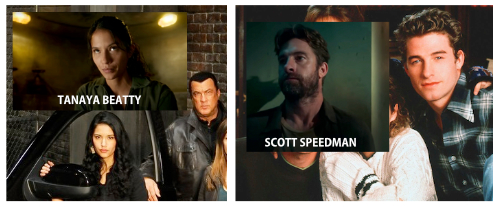
Lang, a shifty guy who’s constantly munching on beet-purple candy bars called SynthBars, is the father of the kid killed in the opening scene. He lives in a seedy-at-least-by-our-standards hotel equipped with a meat freezer for the corpse. We’ll come to learn that he’s the leader of a subversive group and this sicko performance idea is really a political act intended to expose a truth that could change the world. Saul starts to investigate and figure out what’s going on, so meeting Lang and doing this disgusting autopsy performance ends up changing his whole world view. Sometimes it’s the grossest decisions that can change your life forever.
This is not a remake of Cronenberg’s 1970 63-minute film also called CRIMES OF THE FUTURE. To be honest I couldn’t make it through that or STEREO (1969), but from what I’ve read it’s not about this. What I didn’t realize until researching is that this is the same movie Cronenberg intended to make in 2003 under the title PAINKILLERS. At one point it was going to star Nic Cage! Plot descriptions from that time exactly describe this movie, and sure enough he told the L.A. Times recently that the shooting script was unchanged from the one draft he wrote in the late ‘90s. The thing I wonder about is that much of the PAINKILLERS press portrayed it as a showcase for a French performance artist named ORLAN, who in real life received a plastic surgery similar to Caprice’s, which I understand to have been a feminist rebellion against the surgery’s usual purpose of conforming bodies to conventional beauty ideals. She’s in her 70s now so maybe she just didn’t want to travel to Greece during a pandemic, but I wonder why she didn’t get a thank you or anything in the credits.
I like that this is a movie that could be an allegory about many things, but none of them are so obvious as to be the only correct answer. I’ve read some interpretations of other viewers and some comments by Cronenberg (who describes Saul Tenser as “an artist who is giving everything he’s got from the inside out to his audience”) and some things other viewers have said, but I have my own reading. Actually, my own readings. Somewhat contradictory ones. (more spoilers coming)
We find that Lang wants Saul to do this public autopsy not for shock value but as a political act: he believes when people see the organs of his son, who was born naturally able to digest synthetics, it will prove that the human race is evolving. When Saul finally does it, the body has been sabotaged, so the message does not get across. The cops going through the trouble to prevent this truth from being revealed is a strong indicator that Lang and his people were onto something.
For Saul it’s a little more personal than just picking a side – he has a choice of continuing to cut out the new organs that keep growing in him, or letting them be and seeing what happens. Ultimately he seems to choose the latter, when he eats a SynthBar (though we don’t know for sure if he digested it or it digested him).
I think this can be a story about accepting new ways even though they seem unnatural to us. For some that could mean lifestyles they don’t understand, or different ways younger generations do things that seem strange to us. It could mean drastic changes to our systems – trying things we’ve been brainwashed to believe are impossible (shifting funds from militaristic cops to social warfare, ending the drug war, forgiving debt, abolishing the electoral college, whatever) but that we might as well fucking try after generations of our shit not working. Considering the content of the movie, though, the metaphor most directly applies to our modern attachment to technology – app-based conveniences that have rapidly changed so much about our culture, our businesses, our politics, our friendships, our health. We tend to see it as unnatural, troubling, worrisome. But I think Cronenberg is suggesting that it’s the next step in our evolution. And I think he’s neither celebrating or lamenting that. It’s not good or bad. It’s both. But it’s inevitable, unavoidable. It’s here. It can’t be stopped, so why deny it?
Traditionally, plastic is a negative symbol. It’s fake. So it can be seen as sad that people like Brecken have nothing but synthetic waste products for sustenance. But I can also see an interpretation where it’s beautiful – our world is polluted with these man-made materials, but the body has figured out a way to digest them. Adapting, like the way plants and insects do in the polluted world of NAUSICAA OF THE VALLEY OF THE WIND. Nature finding a way. A very creepy way that’s hard for us to accept, but a way nonetheless.
I think Cronenberg is fascinated by militants. The underground movement here is much like the one in SCANNERS – menacing, but probly right. Both the government and the citizens who know of them fear them because their goals would shatter the status quo. Most movies treat rebellions in heroic terms so you’ll root for them, but Cronenberg’s not gonna align your spine and esophagus so he can spoon feed it to you. He’s gonna make them scary. Because revolutions are scary. Change is scary. In this case it’s our whole world, and our very bodies that are changing, and that’s a very scary thing to face. So if you’re able to read any amount of sincere acceptance into the ending here, I think it counts as heartwarming for Cronenberg.
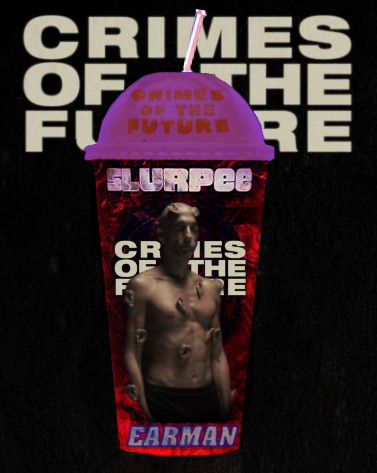 I really dug this one. It’s a good standalone, but if you think about it THE FAST AND THE FURIOUS also seemed like a one-and-done story about an undercover person changing their sympathies by the end of the movie, but they decided to make a sequel and over time it snowballed into one of our biggest pop culture institutions. So I’ll keep my intestines crossed for CRIMES OF THE 2UTURE heading our way in a few years. Of course, if it’s not a big enough hit this summer they might have to go the DTV sequel route like SCANNERS did, so we’ll get a series of numbered CRIMES OF THE FUTURE sequels followed by the spinoff CRIMES OF THE FUTURE COP. Or I suppose it’s more likely these days to get a bunch of TV spinoffs like Crimes of the Future: S.D.U. (Synthetics Digestion Unit), etc. Whatever happens, I think we can all agree that CRIMES OF THE FUTURE is the most exciting new intellectual property of our time. Let’s hope Hollywood learns the right lessons from its runaway success (I’m assuming; have not check box office or zeitgeist charts).
I really dug this one. It’s a good standalone, but if you think about it THE FAST AND THE FURIOUS also seemed like a one-and-done story about an undercover person changing their sympathies by the end of the movie, but they decided to make a sequel and over time it snowballed into one of our biggest pop culture institutions. So I’ll keep my intestines crossed for CRIMES OF THE 2UTURE heading our way in a few years. Of course, if it’s not a big enough hit this summer they might have to go the DTV sequel route like SCANNERS did, so we’ll get a series of numbered CRIMES OF THE FUTURE sequels followed by the spinoff CRIMES OF THE FUTURE COP. Or I suppose it’s more likely these days to get a bunch of TV spinoffs like Crimes of the Future: S.D.U. (Synthetics Digestion Unit), etc. Whatever happens, I think we can all agree that CRIMES OF THE FUTURE is the most exciting new intellectual property of our time. Let’s hope Hollywood learns the right lessons from its runaway success (I’m assuming; have not check box office or zeitgeist charts).



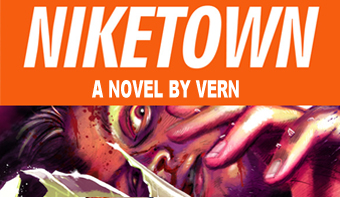

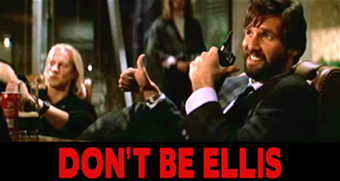










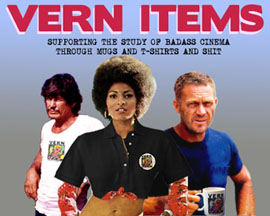








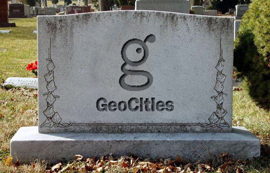
June 9th, 2022 at 3:51 am
The sequel should be called Crimes of the Fu 2 R
Sounds great, hope it gets to my neck of the woods when it opens wide next week. Nothing like a little competition from your son to kick your ass into gear, huh?